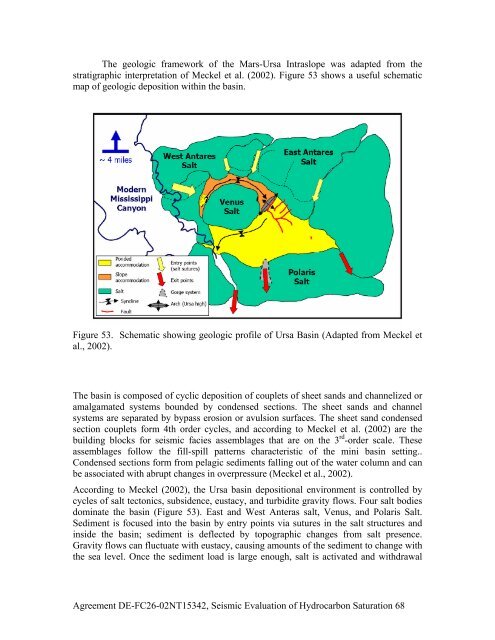Agreement DE-FC26-02NT15342, Seismic Evaluation of ...
Agreement DE-FC26-02NT15342, Seismic Evaluation of ...
Agreement DE-FC26-02NT15342, Seismic Evaluation of ...
You also want an ePaper? Increase the reach of your titles
YUMPU automatically turns print PDFs into web optimized ePapers that Google loves.
The geologic framework <strong>of</strong> the Mars-Ursa Intraslope was adapted from the<br />
stratigraphic interpretation <strong>of</strong> Meckel et al. (2002). Figure 53 shows a useful schematic<br />
map <strong>of</strong> geologic deposition within the basin.<br />
Figure 53. Schematic showing geologic pr<strong>of</strong>ile <strong>of</strong> Ursa Basin (Adapted from Meckel et<br />
al., 2002).<br />
The basin is composed <strong>of</strong> cyclic deposition <strong>of</strong> couplets <strong>of</strong> sheet sands and channelized or<br />
amalgamated systems bounded by condensed sections. The sheet sands and channel<br />
systems are separated by bypass erosion or avulsion surfaces. The sheet sand condensed<br />
section couplets form 4th order cycles, and according to Meckel et al. (2002) are the<br />
building blocks for seismic facies assemblages that are on the 3 rd -order scale. These<br />
assemblages follow the fill-spill patterns characteristic <strong>of</strong> the mini basin setting..<br />
Condensed sections form from pelagic sediments falling out <strong>of</strong> the water column and can<br />
be associated with abrupt changes in overpressure (Meckel et al., 2002).<br />
According to Meckel (2002), the Ursa basin depositional environment is controlled by<br />
cycles <strong>of</strong> salt tectonics, subsidence, eustacy, and turbidite gravity flows. Four salt bodies<br />
dominate the basin (Figure 53). East and West Anteras salt, Venus, and Polaris Salt.<br />
Sediment is focused into the basin by entry points via sutures in the salt structures and<br />
inside the basin; sediment is deflected by topographic changes from salt presence.<br />
Gravity flows can fluctuate with eustacy, causing amounts <strong>of</strong> the sediment to change with<br />
the sea level. Once the sediment load is large enough, salt is activated and withdrawal<br />
<strong>Agreement</strong> <strong>DE</strong>-<strong>FC26</strong>-<strong>02NT15342</strong>, <strong>Seismic</strong> <strong>Evaluation</strong> <strong>of</strong> Hydrocarbon Saturation 68
















